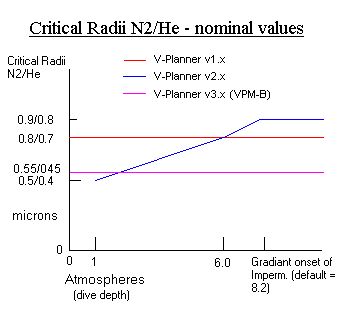Since the thread on Deep stops has been closed (and this question removed), and I had a relatively simple question about the VPM model, I'll just quote myself. This was a response to a claim that there could be no such thing as VPM-B+7 (+7 being a conservatism setting that is out of range on commercial planning software without fiddling around)
Basically, VPM relies on a few parameters, listed below (happy to be corrected if I'm wrong, I don't seem to be able to get the FORTRAN code from decompression.org)
Anyone able to tell me why we would be unable to force the parameters Critical_Radius_N2_Microns, Crit_Volume_Parameter_Lambda, Surface_Tension_Gamma, or any of the others to whatever value we want?
This question was initially meant for rossh after many claims that VPM is consistent while GFs are not, but if anyone is able to answer it, or provide some sort of hypothesis, it'd be quite appreciated.
(And I do hope I'm not violating any rules....)
So VPM-B+3 is fake as well, I assume, since it's a fudge adding conservatism?
Edit: If VPM-B +3 is "real and existing and proven", where is the limit in conservatism in terms of parameters of the model, and why are those limits what they are? (since VPM is "internally consistent" or something like that by your words, you should be able to tell us why, physiologically, those limits are set)
Basically, VPM relies on a few parameters, listed below (happy to be corrected if I'm wrong, I don't seem to be able to get the FORTRAN code from decompression.org)
Altitude_Dive_Algorithm='OFF' !Options: ON or OFF
Minimum_Deco_Stop_Time=1.0 !Options: real positive number
Critical_Radius_N2_Microns=0.8 !Adj. Range: 0.2 to 1.35 microns
Critical_Radius_He_Microns=0.7 !Adj. Range: 0.2 to 1.35 microns
Critical_Volume_Algorithm='ON' !Options: ON or OFF
Crit_Volume_Parameter_Lambda=7500.0 !Adj. Range: 6500 to 8300 fsw-min
Gradient_Onset_of_Imperm_Atm=8.2 !Adj. Range: 5.0 to 10.0 atm
Surface_Tension_Gamma=0.0179 !Adj. Range: 0.015 to 0.065 N/m
Skin_Compression_GammaC=0.257 !Adj. Range: 0.160 to 0.290 N/m
Regeneration_Time_Constant=20160.0 !Adj. Range: 10080 to 51840 min
Pressure_Other_Gases_mmHg=102.0 !Constant value for PO2 up to 2 atm
Anyone able to tell me why we would be unable to force the parameters Critical_Radius_N2_Microns, Crit_Volume_Parameter_Lambda, Surface_Tension_Gamma, or any of the others to whatever value we want?
This question was initially meant for rossh after many claims that VPM is consistent while GFs are not, but if anyone is able to answer it, or provide some sort of hypothesis, it'd be quite appreciated.
(And I do hope I'm not violating any rules....)






